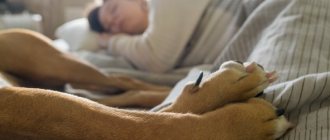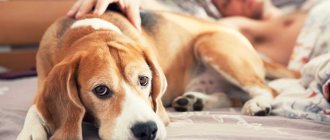Questions for a veterinary surgeon
Animals are characterized by deep sleep, which is accompanied by rapid eye movements and intermittent breathing. It is in the stage of deep (rapid) sleep that people dream, and it can be assumed that dogs also dream. To prove this, we can cite numerous examples of how dogs in their sleep begin to move their legs, imitating running, whine, and wag their tail. This fact is confirmed by scientists. Moreover, it turned out that representatives of small breeds dream more often than large animals, but large animals sleep last longer.
Scientists, based on studies aimed at studying the brain activity of dogs during sleep, have concluded that pets dream of typical daily events - eating a piece of meat, chasing a cat, playing with the owner. It turned out that puppies dream more often. It is assumed that this is due to the processing of a huge amount of newly acquired experience.
Dreams - do dogs see them?
Pets not only see dreams, but also react to them - paw movements, sounds, restlessness or contented whining.
Dreams are about chasing prey, walking with the owner. If your pet is very worried or nervous, then you can interrupt unpleasant dreams by calling him by name. You should not touch the dog with your hands: plunging into deep sleep will not allow the animal to quickly orient itself and will lead to a bite to a person.
What do animals dream about?
So far no one has been able to “spy” on the dreams of animals. However, scientists have reason to believe that they are more diverse than we might imagine. Definitely, often a dream is a reflection of what has been experienced. Therefore, the central part of the plot is usually the owner, who is the center of the universe for the dog. Often dogs in which the “blue spot” was neutralized, in the active phase of sleep, did everything the same as during the day: played, followed commands, ran.
However, studies have shown that it is during sleep that ancient instincts manifest themselves in animals. Thus, even trained dogs, whose ancestors served humans for many generations, can begin to howl like wolves during the deep phase. And under the influence of drugs, they completely demonstrated original behavior: even decorative dogs could “go hunting” and demonstrate behavior characteristic of their ancestors in the pack.
During sleep, ancient instincts appear in an animal
Dogs have a third eyelid
Often when you see your dog's eyes open while sleeping, are they actually closed? Well, the truth is that you can see your dog's third eyelid. This is a light pink/red fabric that covers your dog's eyes to keep them moisturized even when they are sleeping and not blinking.
It's called a membrane that helps protect your dog's eyeballs. The gland located on it is responsible for 40-50% of your dog's tears. This membrane basically functions like a regular eyelid in that it also keeps debris from sticking to your dog's eyes. It also acts as a kind of windshield wiper blade to sweep foreign materials out of your dog's eyes since they can't rub their eyes very well the same way you and I do when we get something in our eye.
How long do dogs sleep?
The amount of time spent sleeping depends on the age of the animal. So an adult dog sleeps from 12 to 16 hours a day. Puppies up to 12 weeks of age spend about 18-20 hours a day sleeping.
Each animal has its own individual characteristics. If your dog sleeps below or above average, there is no need to worry about it. Various factors influence sleep duration, including environmental conditions, gender, age, and breed. By the way, large breeds (St. Bernard, Newfoundland, Great Dane) spend up to 18 hours a day sleeping. However, if there is a sudden change in your pet’s habits, then there is no need to ignore it. Perhaps the animal has hidden health problems.
Older pets aged 7 years and older spend more time sleeping than younger pets. Older animals need rest due to their age and decreased physical and mental activity.
Animals do not adhere to a sleep schedule and can fall into a doze at any time, especially after eating or walking. A bored pet will also spend time sleeping. Working animals tend to become accustomed to an active lifestyle and may spend less than 12 hours sleeping. Instincts will not allow the animal to sleep for a long time; for example, the border collie, due to its natural working qualities, is forced to wake up in order to fulfill the immediate duties of a herding dog.
Functions and structure of the third century
Unlike cats, dogs do not control the functioning of their third eyelid . There are breeds for which drooping eyelids and exposure of part of the eye are considered normal. However, for most dogs, this is not the norm.
The third eyelid closes only when the dog sleeps or blinks (this is an unconditioned reflex), if it does not “hide” while awake, this may indicate problems:
- Neurological disorders - with atrophy of nerve endings, the third eyelids may look asymmetrical. A sudden change may indicate a stroke or traumatic brain injury.
- Inflammation of the mucous membrane of the eye - in this case, the third eyelid swells and goes beyond the normal limits. Typically, inflammation affects the entire eye, causing redness and increased tearing.
- Minor trauma to the eye can result in a hematoma that affects the third eyelid.
Note! A dog can actually sleep with its eyes open if (!) it is under general anesthesia. Under the influence of narcotic drugs, all the muscles of the body relax, the dog’s eyes open. For a short-term operation (up to 20 minutes), no manipulations are performed. After the procedure, the eyes are instilled with saline solution. If the operation lasts longer, the eyelids are glued with adhesive tape or the eyes are constantly moistened.
#6 Training for defense
Some dogs are trained to attack intruders, trespassers and aggressors, hence it is best to avoid approaching dogs in this category. Be careful when entering someone's territory or approaching a stranger to avoid provoking an attack reaction. As an owner, play less games like tug of war, for example, to prevent your dog from feeling superior and displaying aggressive behavior.
Favorite poses for relaxation
Observations of dogs allow us to identify several positions in which dogs usually sleep:
- curl up - in this position the body is grouped, the dog’s safety is ensured;
- on the side - a comfortable position;
- on the stomach - this is a position of insecurity, in which the pet does not relax;
- on the back - a pose of the highest trust, in which the dog expresses confidence in its safety.
Sleep is an indicator of a dog's health. If a pet suffers from insomnia, anxiety, or, conversely, constant drowsiness, this should alert the owner and be a reason to visit a veterinary clinic specialist. Early diagnosis of illness is the key to a successful and quick recovery.
Source
Why doesn't the dog sleep
Nervous, sensitive individuals may experience restless sleep. If your pet sleeps less than average, you can move its sleeping place to a more secluded, secluded, quiet place.
If your pet frequently wakes up at night and becomes active, it may not be getting enough exercise during the day. A similar problem is common in families where the pet sits alone at home all day, and the owner, tired after work, takes him for a walk in 10 minutes. It is known that a tired and well-fed dog sleeps long and soundly. Therefore, it is important to walk your pet for as long as possible before going to bed, physically loading it.
Animals have a heightened sense of hearing and smell. It is likely that your pet is awakened by an unfamiliar smell or sound.
Stress affects sleep duration. Therefore, you need to find out the cause of stress and then take the necessary measures to eliminate this cause. So, if an animal finds itself in a new home, then you need to give it time to adapt.
A place to sleep and rest for a dog
The possibility of recuperation requires a serious approach to choosing a place and a bed for rest. The place must meet the requirements:
- privacy – a sense of security and the opportunity to relax and unwind;
- absence of drafts;
- distance from the doors will eliminate accidental injuries when opening/closing doors;
- distance from the kitchen (preparing various dishes is an irritating factor for the animal and a reason to go to the kitchen once again);
- remoteness from the battery will prevent the animal from overheating;
- distance from electrical appliances, audio systems, air conditioners.
The bed, which is placed in the place allocated for the dog, must be:
- comfortable, soft, cozy;
- match the size of the dog;
- constructively satisfy the requirements of the breed, for example, be in the form of a house where the pet can hide.
How safe is it for the owner?
Often the human body reacts normally to a pet sleeping nearby. However, there are several circumstances that can make co-sleeping harmful. These include both fleas and the risk of catching an infection.
You should be careful if you have allergies
Husky in an apartment: can you keep it, care and maintenance?
An allergic reaction to animal fur is one of the reasons why you should give up your pet on your bed. As a rule, the body is more sensitive at night, and therefore sharing sleep will not bring pleasure and can trigger asthma. If you have allergies, it is recommended to remove your dog's bed from the bedroom. Linens should be changed more often and the house should be cleaned regularly.
Increased risk of getting meningitis
There is an opinion that if an animal sleeps on a bed, especially on a pillow next to the owner’s head, the latter risks its health. He can get meningitis, Chagas disease, staphylococcus, and various parasitic diseases.
Note! The presence of a dog on bedding is rarely likely to cause serious illness. The risk of contracting meningitis from a pet is less than becoming a victim of a shark.
Sleeping with a dog rarely leads to infection, but it's always worth remembering about hygiene
Sleepy behavior - the dog is dozing
When your dog naps, you can get an idea of the quality of his sleep by his behavior.
Sleep is important for the body's healing and repair, and REM sleep, which is the deepest stage of sleep, is the most restorative.
Pay attention to these signs and behaviors to make sure your dog is getting the best sleep possible.
Why does a dog sleep with his eyes open?
Symptoms of illness in dogs can range from mild to severe. Many of them may disappear on their own, but not in an acute form. Symptoms such as loss of consciousness, seizures, difficulty breathing, high or low fever, and others are signs that your dog requires emergency veterinary care.
1. Loss of consciousness. The dog may suddenly lose consciousness; this may be preceded by trembling and convulsions. The dog stops responding to external stimuli and falls into a coma. She may shake her head and bite invisible objects.
2. Collapse. There are several signs of collapse.
An ancient trick
The structure of the human eye is different from dogs; we do not have a third eyelid. More precisely, it is there - a small red bump in the corner of the eye - this is a rudiment and that same third eyelid. Man no longer needed it in the process of evolution. The crown of evolution is man, who stopped feeling the danger of the wild world and got the opportunity to sleep peacefully in a concrete bastion, among the same monolithic buildings. We are no longer in danger of being attacked by a bear or other predator (unless we sleep in the forest and ask for trouble).
The dogs are still surviving. Many four-legged animals live in the wild, wander and fight for life every day. Tailed animals have highly developed instincts of self-preservation; they obey the law of nature and are careful. One of the main laws of survival and procreation is getting healthy, deep sleep. Most of the time when a dog lies with his eyes closed, he is not sleeping, but dozing. The animal is relaxed, but hears everything and, if necessary, will jump to its feet with lightning speed and defend itself.
Sleeping in the wild and safety are incompatible concepts. When a dog sleeps, it is defenseless, does not see or hear anything, which means a predator can sneak up on it. Sleeping with your eyes open is a trick to deceive your attacker! Dogs adopted this skill from their ancestors, most likely from ancient lizards.
The mucous membrane of the eye requires constant hydration, which is why the dog blinks. When the eyelids close, they lubricate the open part of the eyeball with tears. If the eyelids do not close, the mucous membrane will dry out and be rejected. A translucent third eyelid comes to the rescue. It covers the unprotected part of the eye, protecting it from drying out.
Advice: take a closer look at your sleeping pet; if you see a transparent film covering the eyes, there is no need to worry. However, it is worth considering whether the pet feels safe and whether it is too noisy in the home. It is quite possible that a dog sleeps with its eyes open without good reason, because this is an ancient instinct, the work of which cannot be explained.
What places do flies bite most often?
Flies can bite pets on all areas of the body, but the ears are the most affected. Flies are attracted by the smell that is formed when a special enzyme is released.
Some dog breeders believe that enzyme production can be reduced by ear cropping. In their opinion, after such an operation, insects stop attacking animals. However, this statement has no evidence, is not supported by scientific research and does not correspond to reality. Flies do not ignore dogs with cropped ears.
On your back, paws up.
Just as curling in a ball keeps your dog warm, sleeping with its belly exposed helps your dog cool down. Since the fur around the belly is thinner and the paws contain sweat glands, exposing these areas is a great way to cope with the heat.
This is also a position that indicates that the dog is very comfortable, which makes his most sensitive areas vulnerable and makes it difficult for him to get to his feet quickly.
A puppy who sleeps in this position likely doesn't have a care in the world. This is a common occurrence during the summer months.
Why does a dog sleep with his eyes open: past habits or signs of illness?
The dog's body suddenly begins to twitch or tremble, the dog rolls its eyes and does not respond to external stimuli.
3. Difficulty breathing. The dog may experience difficulty breathing, it begins to choke, makes strange noises when breathing, the tongue may turn blue, and swelling may appear.
4. Temperature change. Normal temperature in dogs should be around 38-39 degrees Celsius. If the temperature drops below 37 degrees or rises above 40 degrees, then your dog has health problems. If you notice that your dog is having trouble breathing, is shivering, or seems lethargic, take his temperature.
5. Bleeding. If you cannot stop your dog's bleeding, you should contact your veterinarian immediately. Prolonged bleeding can lead to loss of consciousness and death.
6. Symptoms of acute pain. When a dog whines or squeals, he is trying to tell you that something is wrong with him. If the problem cannot be solved at home, then you should consult a veterinarian.
7. Change in the dog's behavior. If the dog becomes lethargic, this may be the cause of a serious chronic illness. Evidence of extreme apathy in dogs is its reluctance to get up from its place, reluctance to move, play and eat.
8. Symptoms that should not be ignored. Vomiting, diarrhea, increased salivation, lack of appetite, constipation, difficulty breathing, increased dryness or oiliness of the coat and skin should not be allowed to last more than 2-3 days. It is also worth paying attention to lameness, weakness, and changes in urination in the dog.
9. Bloating. A dog's belly that is too large or bloated is a sign of serious problems. If your dog has abdominal pain, whines, and flinches when you touch him, this may indicate poisoning or kidney problems.
10. Other symptoms that require urgent veterinary attention. In the event of an accident, fall, fight, shock, injury or trauma, the dog must be taken to the veterinarian. If you notice that your dog has been poisoned or swallowed a sharp object, then you should not wait, but you should immediately take him to the clinic. It’s better to be on the safe side than to regret later what you didn’t do.
What to do if your dog has seizures
If you notice that your dog is sleeping with his eyes open and seizures are the cause, the most important thing to remember is to remain calm. There's not much you can do other than keep an eye on him, make sure he's safe, and let it pass.
It's best to leave it alone, but if your dog is banging against something or in danger of falling off a couch or other surface during a seizure, you should move him to the floor and away from any walls or furniture so he can't hurt himself.
© shutterstock
A popular and harmful rumor is that you should stick your hand in your dog's mouth during a seizure to make sure he doesn't swallow his tongue. Don't do this as tongue swallowing is a myth and putting your hand in your dog's mouth will only interfere with breathing and may even cause a bite.
Again, try to remain as calm as possible and don't yell or do anything to further upset your dog during a seizure. Simply sit quietly or talk to him in a quiet, soothing tone, stroking him gently to let him know you're nearby. If you can, try recording the incident on your phone or ask someone else in the house. This way, if you need to contact your veterinarian, you can better describe or show him your dog's behavior.
#1 Possessiveness
All dogs have some level of ownership, whether it's food, a toy, or their person. Any action that they perceive as an attempt to take away the object of their adoration can provoke a defensive reaction. Use extreme caution when approaching any animal that is eating or playing with an object and, if necessary, have its owner approach you rather than you approach it.
Dangerous causes and their symptoms
If your puppy or dog sleeps all the time, check to see if they have other external symptoms. If lethargy persists even while awake, there is no appetite and extreme thinness, the cause of the unusual behavior should be sought in stress or illness.
Stress
Stress is the body’s response to a stimulus that occurs when it is unable to adapt to it. It can be short-term or chronic. The first type goes away on its own within a couple of hours or days, while the second poses a serious health hazard and requires outside help.
Stress can be recognized not only by apathy, but also by aggression that is unusual for a pet. Other symptoms include greedily eating food and inedible objects, avoiding human contact, or persistently seeking attention - for example, by relieving yourself in the wrong place or damaging things.
Disease
Apathy, loss of activity, poor appetite and drowsiness are characteristic not only of stress, but also of other diseases: infections, parasites and poisoning. Until more specific signs appear, only a veterinarian can make an accurate diagnosis.
Tar
An excellent fly-repellent product is birch tar. It is not difficult to find it in its pure form; it is available in many pharmacies. You can anoint your dog's ears with tar without any consequences for him.
Its smell is very unpleasant, but you have to put up with it, since its benefits are undeniable. You can treat your dog with an ointment containing tar, but first study the instructions. It is not recommended to use various tar ointments containing hormones for preventive purposes.
Trembling and yelping of a toy terrier
Hello, we have a toy terrier (4 years old). At night she began to squeal and tremble violently, as if a sharp pain was piercing her. At the same time, the stool is normal, there is no vomiting. The trembling did not go away by morning, the condition was sluggish, painful, the nose was dry. Temperature 37.8, breathing frequently. This has not been observed before. What could it be?
Answer 1
This is a breed of emotional dogs. They experience regular nervous and emotional overexcitation. Physically, it manifests itself as a shaking body, which is normal.
The toy terrier is constantly afraid. He is afraid of noise, screams, sudden changes in the situation, large animals, and unfamiliar people. Adaptation occurs slowly. The baby is trembling and trying to attract the owner's attention. Simulates pain. Requires regular attention, smart, cunning.
Need causes the same reaction. An animal accustomed to the tray endures it, shaking. The thin skin makes it react sharply to temperature changes. Blankets and overalls save.
A high temperature accompanied by shuddering is a sign of illness. Fever increases the temperature. The dog's nose is dry. There is lethargy and lack of interest. Veterinarian intervention is required. Treatment is prescribed.
Humans are the source of infection
An animal cannot catch a human disease. Viruses provoke inflammation at the source of infection. A weakened body suffers. Immune protection is destroyed.
The human strain of the virus is not the same as the quadruped strain. The presence of infection excludes the moment of infection during transmission. Pets become infected from other similar ones. Also sources are wild, homeless animals.
It is impossible for the owner to become a source of infection. It is possible to become a generator of causes that cause a chance of getting sick. Inattention and poor quality food do their job. The pet catches the infection.
It is important to take care of your four-legged friends. A caring owner follows the recommendations of medical workers and breeders. The owner provides comfortable living conditions and is responsible for the safety of his little friend.
Symptoms of the disease
The symptoms of various diseases are similar to each other. Trembling is a universal reaction of the body experiencing discomfort. Poisoning, virus, infection cause similar symptoms. The animal shakes, its body temperature changes.
Shaking is worth paying attention to if you don't usually see this. Symptoms may be observed: the dog is lethargic, refuses to eat, and behaves strangely. The animal falls and breathes heavily.
Poisoning will be indicated by the remains of uneaten food. Medicines, sweets, and plastic are dangerous. Medical attention required. The “glutton” is being taken to the doctors.
An elevated temperature accompanied by muscle contraction indicates illness. The patient is lethargic and lies down. May whine. Prolonged tremors require medical intervention.
Psychological
Some dog breeders associate paw twitching with psychology. Owners and familiar people scratch the dog, caress it, and share positive emotions with it. The pet is calm and does not jerk its limbs when its sides are scratched. Sometimes habitual affection becomes unpleasant for the dog, and the reflex appears. Breeders advise to properly scratch and stroke your pet. A dog perceives affection better when it is relaxed, does not play or ask for food, and does not communicate with other dogs.
When a dog's paws twitch, the owner's movement resembles a slight attempt to reach the area of irritation.
On the side
A dog that sleeps on its side should feel safe and comfortable as vital organs remain unprotected.
Dogs that prefer this position are usually quite calm and relaxed, although they may switch to a different position if they are sleeping in a new place or with someone they are not familiar with.
This position also allows the limbs to move during sleep, which is why you may see more twitching and kicking from a side-lying dog.
Causes of seizures
Muscle shaking and cramps are caused by many diseases:
- infections of a viral, fungal, parasitic, bacterial nature;
- chronic diseases of the liver, kidneys, heart, gall bladder;
- pathologies of the cardiovascular system;
- tumors of the spine, brain;
- inflammatory processes of a non-infectious nature;
- injuries of the spine, internal organs, head. Even those that seemed insignificant and which the owner had long forgotten about;
- severe poisoning (toxins, poisons, metals), bites of poisonous insects, snakes;
- hypoglycemia (low sugar);
- polycythemia (increased number of red blood cells).
- congenital pathologies, diabetes, epilepsy, exhaustion, electric shock.
Plant decoctions
If flies circle over the dog and try to “occupy” its ears, you need to treat them with a strong decoction of bay leaves.
Pour a pack or two of “lavrushkas” with a liter of boiling water, cover with a lid and let it brew. When the broth has cooled, thoroughly moisten the gauze and “wet” the dog’s ears as thoroughly as possible. Make sure that the broth does not get inside the ear. The taste of this solution is very bitter, and the smell is very effective in repelling flies. A decoction of wormwood has a similar effect, and in addition, an excellent remedy would be to hang bunches of wormwood in the enclosure or even “push” it into all the cracks of the booth. You can practically caulk the booth with dry wormwood. The main thing is that you can smear with such decoctions as often as necessary.
Stretched out on your stomach.
This is sometimes called the "Superman" pose. This allows the dog to jump out and be on his paws immediately.
You often see this position in puppies who need to take frequent naps, but also want to be ready to jump up and play at a moment's notice.
Dogs who sleep in this position don't want to miss out on the chance to get in on the action, even while they're dozing. This is the preferred position for high-energy puppies or puppies that fall asleep while playing and just want to plop down on the ground.
How to distinguish deep sleep from a seizure
If you doubt your pet's well-being, wake him up. Normally, the pet will quickly regain consciousness and return to its normal activities. If your companion does not wake up or is shaking, you should immediately call a veterinarian. Also an alarming sign is severe weakness after waking up. It may indicate a previous seizure.
The appearance of foam from the mouth is one of the most alarming symptoms
Movements during sleep are a consequence of the onset of the REM phase. Intervention is required only in cases where the pet develops uncharacteristic symptoms: weakness, disorientation in space, etc.
Don't wake up your dog abruptly
The phrase is true: “Don’t wake a sleeping dog!” After all, 60% of child bites from pets occur when children wake up an animal that is in REM sleep. The reaction of animals at this moment is comparable to a human one, when a person is disoriented from a sudden awakening and can hit the person waking him with his hand, fall out of bed, etc. Therefore, it is important to explain to children that they should not wake up a sleeping dog or frighten it.
Similar articles:
- Tests for choosing a puppy
- Stripping for dogs
- Nose color in dogs
- Why does a dog mark territory?
- Shelter dogs
- Dog safety in the car
Treatment
Only a doctor should prescribe medications and treatment. For a high-quality diagnosis, it is necessary to take blood and urine tests. Additional research will be required:
- Ultrasound; MRI; CT; ECHO;
- X-ray of the spine, skull;
- examination by a veterinarian-neurologist.
The priority and need for research is determined by the doctor.
Immediately, even before detailed tests, the veterinarian may prescribe intramuscular injections of magnesium sulfate. Thanks to the antihistamine effect of the drug, attacks will not recur in the near future. Then, more detailed treatment will follow. It is dangerous to administer the drug yourself.
The main reason why an animal cannot be cured is neglecting the veterinarian’s recommendations and stopping treatment on its own. It's a big mistake to rely on your own judgment. It may seem that everything is fine with your pet, there have been no seizures for a long time and it is enough to stuff him with medications. However, only a specialist can say with confidence that the disease has receded, after confirming a visual examination with additional studies. A methodical approach to treatment depends on the owner, and professional recommendations depend on the doctor.
Back to back or pressed up
You may find your dog sleeping with his back to your other pets or cuddled up to you, and this means the same thing. Your dog becomes attached and shows that he wants to bond with you or his furry siblings.
A dog sleeping this way feels very loving and affectionate and is completely comfortable with whoever he is napping with.
Try showing your love in return by taking a nap with your pup.











